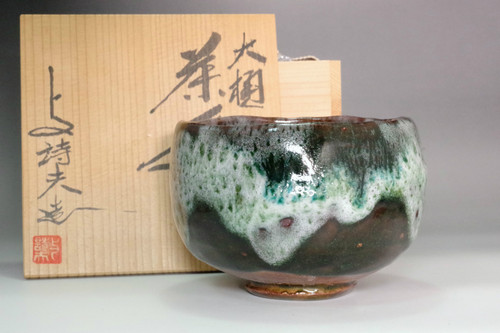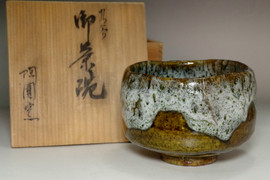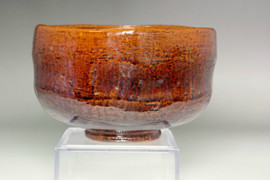Iwamura Yoshio (1925-1987) Vintage Ohi pottery teabowl #4982
- SKU:
- 4982
- Shipping:
- Free Shipping
- width: approx. 12.7cm (5in)
- height: approx. 8.5cm (3 11⁄32in)
- weight: 280g (w/ box 562g)
This tea bowl is a masterpiece that evokes the beauty of nature and the warmth of handmade craftsmanship. The deep green and white glazes blend together, creating a unique pattern reminiscent of a mysterious forest shrouded in mist. This gradation expresses the transitions of nature, making each pattern one-of-a-kind and adding to its unique charm. The bowl's rounded shape is designed to fit comfortably in the hand. The thick ceramic texture provides a sense of reassurance when held it. Particularly noteworthy is the unique shine of the glaze. The way it changes appearance depending on the light and angle allows you to enjoy different aspects of its beauty from various perspectives.
Iwamura Yoshio
1925-1987
male
ohi pottery
Studied under Izukura Juro in Kaga. Later founded the Oyabu kiln there. Member of the Asia Art Society and the Kaga Art Association. Director of the Ohi Ware Craft Cooperative. Creates Ohi ware tea cups and colored vessels, mizusashi, and decorative items.
Ohi ware
In Genbun 6 (1666) Tsunanori, fifth of the Maeda line and daimyo of the Kaga Domain, wanted to cultivated tea culture and invited the 4th head of the Uransenke school of tea ceremony, Senso (Soshitsu Sen), to be the tea ceremony magistrate. At that time Senso was accompanied by a potter and tea bowl master, Chozaemon, who was the best student of the 4th head of the Raku line, Ichinyu.
Chozaemon was searching for the best potter's clay and upon discovering it in Ohi village in Ishikawa prefecture, he continued living and making pottery there in Kaga. He then took the surname Ohi from the village and it continues to be used to this day.
Ohi- ware is "Wakigama" (which is a general term for kilns used to make Raku ware that are outside of the Raku line) of the Kyoto Raku line. Raku ware has spread throughout Japan since the Meiji period, but in terms of makers who have directly inherited the Raku line techniques, Ohi ware is said to be the only current Wakigama with such lineage.
Fine quality earth is coated with a red-yellow glaze, commonly known as Ohi Amber glaze, and fired at a low heat of 750-850 degrees. Ohi ware is defined by the brilliant reddish-brown luster of the bowls' surface created by using the Amber glaze.

















